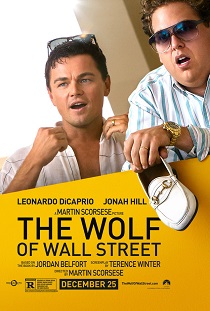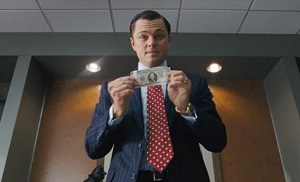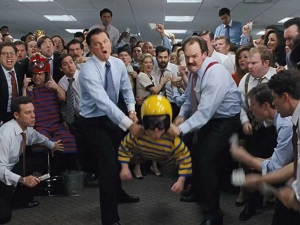 This movie review appears in a shorter version on Lawrence.com.
This movie review appears in a shorter version on Lawrence.com.
If there’s one thing The Wolf of Wall Street doesn’t lack, its courage. There isn’t a movie in recent memory that I’ve seen (Fear and Loathing in Las Vegas included) with this much nonstop debauchery from its awful, awful main characters.
Director Martin Scorsese uses all of his formidable cinematic prowess to create the most unlikely and outrageous comedy of the year—a three-hour operatic orgy that indicts the modern version American dream more savagely than ever.
The lustful, greedy heart of post-Woodstock, pre-Watergate America was exposed in Gonzo journalist Hunter S. Thompson’s drug-fueled, mournful masterpiece Fear and Loathing in Las Vegas, and The Wolf of Wall Street already feels like its modern equivalent, even if it is set in the 1990s.
 Based on the memoir of convicted stock defrauder and money launderer Jordan Belfort, The Wolf of Wall Street has a go-for-broke mentality that mirrors the addictions of its sociopathic main characters. As a fascinating portrait of ego and denial, the movie makes a nice companion piece to two of this year’s best movies, Spring Breakers and The Act of Killing. Ironically, the tones of these three films couldn’t be more different.
Based on the memoir of convicted stock defrauder and money launderer Jordan Belfort, The Wolf of Wall Street has a go-for-broke mentality that mirrors the addictions of its sociopathic main characters. As a fascinating portrait of ego and denial, the movie makes a nice companion piece to two of this year’s best movies, Spring Breakers and The Act of Killing. Ironically, the tones of these three films couldn’t be more different.
Leonardo DiCaprio is at his dynamic best as Belfort, a man who lives in his own hedonistic reality—dulling his sense of responsibility and moral direction with nonstop sex, alcohol, and Quaaludes. Lunch with his first Wall Street boss (a scene-stealing Matthew McConaughey) has him wondering how much of this cocky attitude is a joke, but as soon as he discovers a “pump and dump” penny stock scheme, he takes that attitude to a surreal level.
 In one of the funniest scenes of the film, DiCaprio singlehandedly redefines—and hopefully puts to rest—the Braveheart-style rallying cry scene that’s become the standard for all action films. In another, he proves that he’s got more than a little prowess in the physical comedy arena, anchoring a ‘lude overdose scene with moves that would raise the hair on Jim Carrey’s neck.
In one of the funniest scenes of the film, DiCaprio singlehandedly redefines—and hopefully puts to rest—the Braveheart-style rallying cry scene that’s become the standard for all action films. In another, he proves that he’s got more than a little prowess in the physical comedy arena, anchoring a ‘lude overdose scene with moves that would raise the hair on Jim Carrey’s neck.
Scorsese keeps up the manic pace of Belfort’s lifestyle for three hours, with long tracking shots, whip-pans, freeze frames, inner dialogue, and DiCaprio both narrating and speaking directly to the camera. You name a cinematic technique, Scorsese uses it here. It’s impossible not to relent to its hallucinatory style, and you may begin to feel a little under the influence yourself.
If you want a movie that examines the intricacies of stock fraud, look elsewhere. DiCaprio starts to explain what Belfort and his fellow miscreants were doing, but then stops suddenly with something to the effect of: “Who am I kidding? You don’t care.” It’s a risky move; insulting the audience directly, and it illustrates perfectly Belfort’s disregard for the “little people.” (And although you’ve seen the dwarf-tossing scene in the previews, I’m actually not even referring to that. That is a whole different level of disrespect.)
 No one character embodies the freakish nature of the movie better than Donnie (Jonah Hill), Jordan’s WASP-y lapdog, an amalgamation of several real-life people. Aside from being flat-out hilarious, he embodies the sycophantic behavior of everyone who followed Jordan into the inferno and encouraged the madness to continue.
No one character embodies the freakish nature of the movie better than Donnie (Jonah Hill), Jordan’s WASP-y lapdog, an amalgamation of several real-life people. Aside from being flat-out hilarious, he embodies the sycophantic behavior of everyone who followed Jordan into the inferno and encouraged the madness to continue.
The Wolf of Wall Street is a cynical, nasty satire about human beings regressing to infantile levels. What does it say about our base, animalistic impulses? I would love for it to be the final, insane word on indecent power-hungry Wall Street behavior, but you and I both know that probably won’t be the case, so trust me, it’s okay to laugh. What else are we going to do?








Comments on this entry are closed.